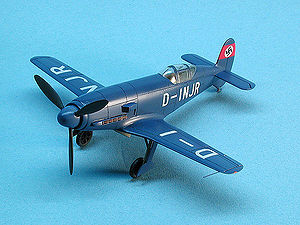Messerschmitt Me 209 Video - Great pictures
|
|
| Late 1930s French World Air Speed Record Prototype |

Picture - Messerschmitt Me 209 V1 (display model showing authentic colors and markings)
Role: Race plane/Fighter
Manufacturer: Messerschmitt
Designed by: Willy Messerschmitt
First flight: 1 August 1938
Number built: 4
Messerschmitt's designation Me 209 was used for two separate projects during the late 1930s and early 1940s. The first, described below, was a record-setting single-engine race plane for which little or no consideration was given to adaptation for combat. The second, the Me 209-II, was a proposal for a new development from the lineage that produced the highly successful Bf 109 that served as the Luftwaffe's primary fighter throughout World War II.
Design and development
The first Me 209 was a completely new aircraft designed only to break speed records whose designation was used by Messerschmitt as a propaganda tool. Although the aircraft was a "single purpose" high-speed experimental prototype, it was hoped that its name would associate it and its world-beating performance with the Bf 109 already in combat service.
The Me 209 was constructed in 1937 and shared only its Daimler-Benz DB 601 engine with the Bf 109. Willy Messerschmitt designed the small aircraft with a cockpit placed far back along the fuselage just in front of its unique cross-shaped tail section. Unlike the Bf 109, the Me 209 featured a broad-track, inwardly-retracting undercarriage mounted in the wing section.
Testing
The aircraft achieved its purpose when test pilot Fritz Wendel flew it to a new world speed record of almost 756 km/h (469 mph) on 26 April 1939 bearing the German civil registration "D-INJR".
The idea of adapting the Me 209 racer to the fighter role gained momentum when, during the Battle of Britain, the Bf 109 failed to gain superiority over the RAF Supermarine Spitfires. The little record-setter, however, was not up to the task of air combat. Its wings were almost completely occupied by the engine's liquid cooling system and therefore prohibited conventional installation of armament. The aircraft also proved difficult to fly and extremely hard to control on the ground. Nevertheless, the Messerschmitt team made several attempts to improve the aircraft's performance by giving it longer wings, a taller vertical stabilizer, and installing two 7.92 mm (.312 in) MG 17 machine guns in the engine cowling. Its various modifications, however, added so much weight that the Me 209 ended up slower than the contemporary Bf 109E.
This first Me 209 project was soon cancelled, and though it never went into wide-scale production, Messerschmitt's design did make its mark with its impressive speed record, which was not officially broken by another piston-engined aircraft until 16 August 1969, by Darryl Greenamyer's highly modified F8F Bearcat.
Propaganda Use
In 1939, the speed record achievement of the Me-209 was used for a propaganda disinformation campaign, wherein the aircraft was given the designation of Me-109R. This disinformation was naturally designed to give an aura of invincibility to the Bf-109, an aura not dispelled until the conclusion of the Battle of Britain.
Survivors
The fuselage of the Me 209 V1 is currently on display, at the Polish Aviation Museum in Krakx³w, Poland.
Specifications (Me 209 V1)
General characteristics
Crew: One
Length: 7.24 m (23 ft 9 in)
Wingspan: 7.80 m (25 ft 7 in)
Height: ()
Powerplant: 1x— Daimler-Benz DB 601 ARJ, 1,342 kW (1,800 hp)
Performance
Maximum speed: 756 km/h (469 mph)
Related development
Bf 109
Me 209-II
Me 309
Me 409
Me 509
Me 609
Bibliography
Feist, Uwe. The Fighting Me 109. London: Arms and Armour Press, 1993. ISBN 1-85409-209-X.
Green, William. War Planes of the Second World War, Fighters, vol. I. London: Hanover House, 1960.
Jackson, Robert. Infamous Aircraft: Dangerous Designs and their Vices. Barnsley, Yorkshire, UK: Pen and Sword Aviation, 2005. ISBN 1-84415-172-7.
Living Warbirds: The best warbirds DVD series.
Source: WikiPedia